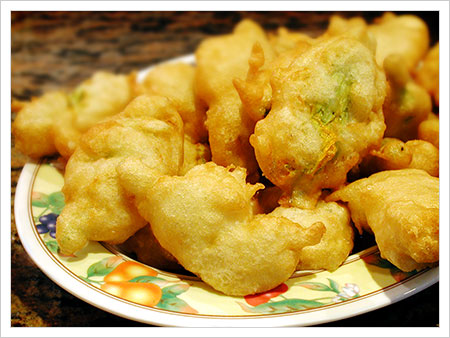Cauliflower needs more love. Americans tend to damn it to side-dish oblivion. Boiled to a bland mush, cauliflower loses most of its flavor. Sadder still, what little taste is left then gets entombed in molten cheese sauce. This recipe aims to lift cauliflower out of its Velveeta-drowned purgatory.
When pan-fried, cauliflower caramelizes. High heat salvages the florets' crunch, drawing out the sweetness sapped by boiling. If you hate cauliflower, give this recipe a whirl and see if you still find it icky.
In much of Rome, the cavolfiore romanesco is a comical and common sight. Looking like a mad botanist's creation, it's sort of broccoli and sort of cauliflower. Bright green, the romanesco variety first emerged in Italy during the 1600s. Its texture is spongy like cauliflower but, once cooked, presents a greener taste more akin to everyday broccoli.
This dish combines market-variety cauliflower and the more alien-looking romanesco. If you can't find romanesco, plain old cauliflower is more than up to the task. Porous florets happily sop up the oil, vinegar and lemon juice dressing.
INGREDIENTS:
- 1 small head of white cauliflower
- 1 small romanesco cauliflower
- 1-2 cloves garlic, minced
- 1 tablespoon capers
- 1/2 lemon, juiced
- 1 anchovy fillets, finely chopped (optional)
- 6-8 pitted olives, chopped
- Red pepper flakes to taste
- 1 - 2 tablespoons balsamic vinegar
- 8 oz of penne
While the water is boiling, heat 3-4 tablespoons of olive oil in a flat skillet over medium-high. Depending on size, you might need more oil. When the pan is hot (but-not-smoking), add cauliflower slivers. Quickly stir the so that all the pieces are coated in oil. :: Stop stirring ::. In order to brown, the cauliflower needs to be in sustained direct contact with the hot pan. Wait 3-4 minutes or until the cauliflower has begun to brown. Continue cooking until browned all over. Remove the florets and set aside.
Cook the penne in 3 quarts of salted water. In the same pan that you cooked the cauliflower, heat another 2 tablespoons of oil. Add the garlic, olives, capers, red pepper flakes and anchovy, stirring occasionally to avoid burning. Cook over medium heat for another 2 minutes -- you will begin to smell the aromatic garlic and the vinegary tang of the capers.
When the garlic starts to caramelize, return the browned florets to the pan. Lower heat and gently mix together, making sure that the garlic and olives and capers get evenly distributed. Dress the florets at this point with the lemon juice and balsamic. Keep cooking for 2-3 minutes over low heat -- or until the juice and vinegar have been absorbed. Toss the cooked pasta together in the pan with the dressed cauliflower. Serve hot.
















